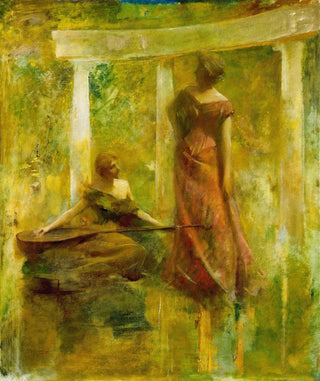Art print | Music - Thomas Wilmer Dewing


View from behind

Frame (optional)
Music Art print - Thomas Wilmer Dewing – Captivating introduction
In the vast panorama of American art history, "Music" by Thomas Wilmer Dewing stands out for its delicacy and enchanting atmosphere. This work, created at the end of the 19th century, invites the viewer to immerse themselves in a universe where sound and color meet, where melody is expressed through painting. The scene depicts female figures, often associated with music and poetry, who seem captured in a moment of suspended grace. The artist succeeds in evoking an intimate, almost ethereal ambiance that transports the viewer into a space of contemplation and daydreaming. The Music art print allows for rediscovering this iconic work, revealing the depth of Dewing's artistic sensitivity.
Style and uniqueness of the work
Dewing's style is characterized by a refined approach and mastery of nuances of light. In "Music," the palette of soft colors, dominated by pastel tones, creates a serene and melodious atmosphere. The female figures, often idealized, are depicted with remarkable finesse, their poses and expressions capturing the essence of harmony and emotion. The artist uses techniques of blurring and transparency, giving his subjects an almost dreamlike appearance. Decorative elements, such as drapes and floral motifs, add an extra dimension to the piece, reinforcing this impression of lightness and dreaminess. Dewing thus manages to transcend simple representation to offer a visual experience that evokes music itself—a symphony of shapes and colors.
The artist and his influence
Thomas Wilmer Dewing, a member of the American artistic movement known as "The Ten," managed to leave his mark on his era with his unique approach to painting. Influenced by the Pre-Raphaelites and Impressionists, he developed a style that combines modern sensitivity with artistic traditions. His work, although less well-known than that of his contemporaries, nonetheless had a significant impact on early 20th-century American art. Dewing often explored themes related to femininity, beauty, and {{123}}

Matte finish

View from behind

Frame (optional)
Music Art print - Thomas Wilmer Dewing – Captivating introduction
In the vast panorama of American art history, "Music" by Thomas Wilmer Dewing stands out for its delicacy and enchanting atmosphere. This work, created at the end of the 19th century, invites the viewer to immerse themselves in a universe where sound and color meet, where melody is expressed through painting. The scene depicts female figures, often associated with music and poetry, who seem captured in a moment of suspended grace. The artist succeeds in evoking an intimate, almost ethereal ambiance that transports the viewer into a space of contemplation and daydreaming. The Music art print allows for rediscovering this iconic work, revealing the depth of Dewing's artistic sensitivity.
Style and uniqueness of the work
Dewing's style is characterized by a refined approach and mastery of nuances of light. In "Music," the palette of soft colors, dominated by pastel tones, creates a serene and melodious atmosphere. The female figures, often idealized, are depicted with remarkable finesse, their poses and expressions capturing the essence of harmony and emotion. The artist uses techniques of blurring and transparency, giving his subjects an almost dreamlike appearance. Decorative elements, such as drapes and floral motifs, add an extra dimension to the piece, reinforcing this impression of lightness and dreaminess. Dewing thus manages to transcend simple representation to offer a visual experience that evokes music itself—a symphony of shapes and colors.
The artist and his influence
Thomas Wilmer Dewing, a member of the American artistic movement known as "The Ten," managed to leave his mark on his era with his unique approach to painting. Influenced by the Pre-Raphaelites and Impressionists, he developed a style that combines modern sensitivity with artistic traditions. His work, although less well-known than that of his contemporaries, nonetheless had a significant impact on early 20th-century American art. Dewing often explored themes related to femininity, beauty, and {{123}}






